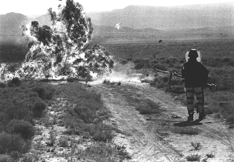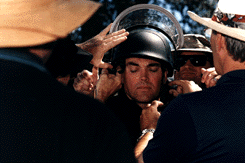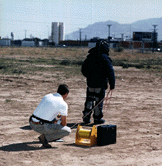
ALBUQUERQUE, N.M. — Disabling sophisticated bombs without getting hurt is what a small team of researchers at Sandia National Laboratories knows how to do best. Now Sandia is sharing its technology and expertise in the occult art of bomb disablement with members of the world’s most elite bomb squads during an eight-day, hands-on training conference in Albuquerque Aug. 11-18.
Operation Albuquerque ’97, as the event is called, focuses on the science and methodology of bomb disablement, with emphasis on emerging technologies that keep “bomb techs” out of harm’s way as they protect the public from criminals and terrorists whose devices grow more sophisticated and dangerous every day. Only members of the most advanced bomb squads are invited to participate.

Sandia hosted the first Operation Albuquerque in 1994 after Chris Cherry of Sandia’s Explosives Applications Department recognized a need to put tomorrow’s bomb disablement technologies into the arsenals of the nation’s busiest bomb squads. The first event received wide acclaim from its participants. This is the third Operation Albuquerque, and the list of invitees has become more cosmopolitan.
Operation Albuquerque ’97 is expected to include 64 bomb techs representing the police departments of major U.S. cities like New York, Chicago, Atlanta, Houston, and Los Angeles; state police departments; federal law enforcement agencies including the FBI and Secret Service; and anti-terrorist and law enforcement agencies from England, the Republic of Ireland, Canada, Norway, Germany, and Australia (host country for the 2000 Summer Olympic Games). Sandia, the Department of Energy, the National Institute of Justice, and the Albuquerque Police Department are sponsoring this year’s event.
To stay ahead of the increasingly sophisticated anti-tamper and explosives devices being encountered in the world today, Cherry and his team research and develop some of the world’s most technically advanced and versatile “render-safe” technologies, along with reconnaissance technologies to help categorize complex, terrorist-type bombs and assess their potential threats remotely.

How Sandia’s disrupters work cannot be disclosed for security reasons, but each is designed to disrupt a bomb’s internal gadgetry so instantaneously that it never has a chance to detonate.
During Operation Albuquerque, the PAN Disrupter and a variety of other Sandia disablers – with cryptic names like the “Black Box” and “Magic Cube” – will be deployed in realistic bomb disablement scenarios by small teams of bomb tech “players” as they practice using the technologies to defeat mock bombs, many of which are booby trapped or have small charges that go off if players accidentally trip the devices.
“These aren’t your run-of-the-mill pipe bombs,” says Cherry. “The bomb techs who come here are concerned about more complex devices. Our goal is to give them the training they’ll need to deal with the kinds of terrorist-type devices we think they’ll encounter in the next 10 to 20 years.”
In past Operation Albuquerque scenarios, teams were dispatched to locate and defeat sophisticated bombs hidden in public places, such as at shopping malls and on the front seats of cars, and disable “body bombs” wired to hostages, for example. This year, participants will respond to more than 48 scenarios throughout Albuquerque. Following each round of scenarios, players and observers from Sandia and the FBI’s Bomb Data Center will discuss and evaluate the teams’ tactical approaches.
Sandia also is a world leader in robotics, and Cherry’s team is adapting a variety of commercial robots to carry out some of the bomb tech’s most risky jobs, such as delivering a disrupter to a bomb’s location. The conference includes training in the use of robotics technologies, as well as classroom instruction and technical presentations on advanced disablement strategies, vehicle bombs, and other issues associated with current terrorist-type threats.
John O’Connor, FBI Deputy Assistant Director for Counter Terrorism; U.S. Sen. Pete Domenici (R-N.M.); U.S. Sen. Jeff Bingaman (D-N.M.); U.S. Rep. Bill Redmond (R-N.M.); and David Boyd, Director of the National Institute of Justice’s Office of Science and Technology are expected to attend a kickoff ceremony and media demonstration on Monday morning, Aug. 11 (see below).
Sandia is a multiprogram Department of Energy laboratory operated by a subsidiary of Lockheed Martin Corp. With main facilities in Albuquerque and Livermore, Calif., Sandia has broad-based research and development programs contributing to national security, energy and environmental technologies, and economic competitiveness.
Photos available
Media are invited to a demonstration of current bomb disablement technologies on Monday, Aug. 11, 9:45-10:30 a.m., at the Albuquerque Police Academy (5412 2nd Street NW). The demonstration will feature a mock terrorist-type bomb being energetically destroyed by a Sandia disabler. The disabler will be delivered to the bomb’s side by a mobile robot. Other attractions include live explosions and bomb techs outfitted with special protective gear. Bomb techs participating in Operation Albuquerque ’97 will be available for interviews following the demonstration.